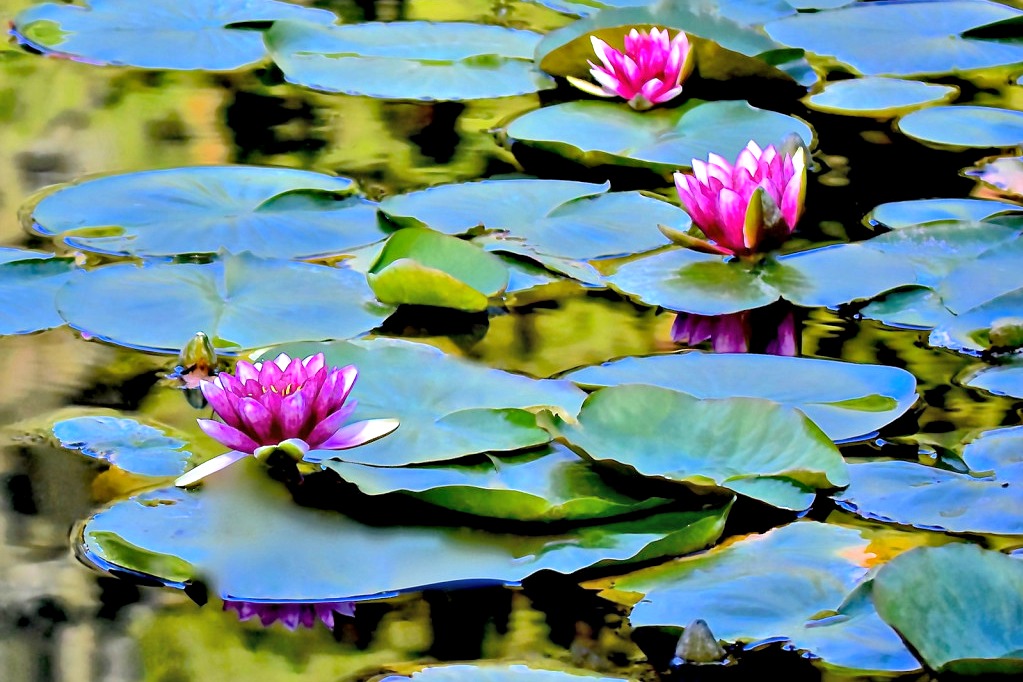In Bloom: Water Lilies
Water lilies rise from the mud in the pond, adding interest and color to the summer garden. (Photo credit: Claudia Cooper)
“In the pond are four kinds of water lilies, one of which is fairly rare. All four of them are fast growers and they must be thinned from time to time to keep them from taking over the entire pond. Under them the smaller fish are protected, while in the summer heat they serve as a retreat from the heat for most pond dwellers.”
Water lily (Nymphaea, known as siuren) has been the Seattle Japanese Garden’s “mud flower” since the garden opened in 1960. In Japan, however, the aquatic plant most often used is sacred lotus (Nelumbo), which isn’t cold hardy in Seattle and would have to be re-planted each year. The two are related, members of the same family (Nymphaeaceae), and both have beautiful, floating flowers emerging from the mud below. Although it doesn’t have the spiritual connotations of lotus, water lily is also used to signify the transformation to purity.
The quotation above, from an Arboretum Bulletin article (Spring 1984) by Kenneth Sorrells, is the most detailed information I was able to find on the types of water lilies planted in our pond. The white and pink-flowered plants currently flourishing here might not be the original forms. However, they definitely belong to the hardy water lily classification, which includes plants which flower in colors of white, yellow, copper, pink or red. The hardy forms bloom over a long period during warm weather, then go dormant when temperatures drop in autumn. Tropical water lilies, which include blue and purple-flowered forms, don’t survive in climates with below-freezing winter temperatures.
All types have rounded, leathery, floating leaves that are deeply notched where the leafstalk is attached. In our garden, the leaves are green, but forms with brightly colored and patterned leaves are also available. Underneath the floating leaves and flowers are thick, submerged rhizomes (a modified plant stem, usually found underground or submerged, from which roots and shoots may emerge).
As Sorrells notes, water lilies are vigorous, and the plants in our pond need to be thinned periodically. Some species, including Nymphaea odorata (fragrant water lily), are considered invasive. In King County it’s labeled a ”non-regulated noxious weed.” The large, fragrant flowers are white, pink or purple, with 20-30 petals and yellow centers. Native to the eastern U.S., it’s been widely introduced into the Pacific Northwest, and dominates in shallow bodies of water, obstructing water flow and interfering with light & oxygen levels. It’s not known whether it was ever planted in the Seattle Japanese Garden.
The Western Washington edition of the booklet “Gardenwise: Non-Invasive Plants for Your Garden” recommends using less aggressive alternatives, but even so, it cautions against placing them in natural lakes and streams.
Although they require periodic thinning --as our gardeners are planning to do in the coming weeks-- and so can’t be considered low maintenance, water lilies add summer color and beauty to our garden. They also provide a colorful but stationary counterpoint to the mezmerizing slow movements of the multicolored fish (koi) that also grace the pond throughout the warmer months.
Corinne Kennedy is a trained guide for Seattle Japanese Garden and a contributor to the garden's blog.

